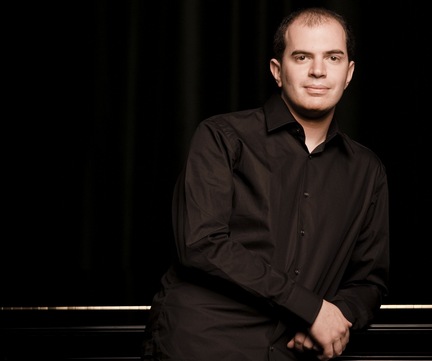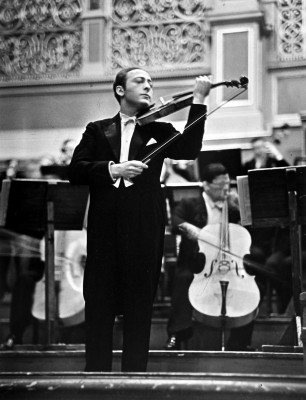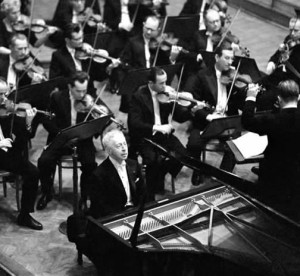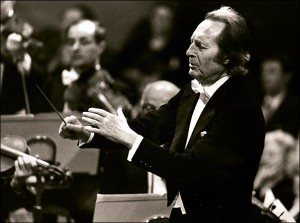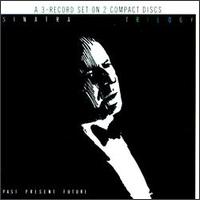
In 1980, Frank Sinatra released his first studio album in 6 years. It was a concept album entitled Trilogy: Past Present Future, the concept being a biography in song of Ol’ Blue Eyes himself. Past featured several standards that Sinatra had (amazingly) never recorded. Present was a collection of “contemporary” pop hits (though, even by 1980 standards, “Love Me Tender” was really pushing it). Present gave us the unfortunate Kander & Ebb power ballad (is that what it is?) “New York, New York”.
But Past and Present don’t really concern us — the singing on both is pretty lame by Sinatra standards, and the arrangements… well, let’s talk about those arrangements. Sinatra assigned each chapter of this triptych to a different arranger: Past to Billy May, Present to Don Costa, and Future to Gordon Jenkins.
It’s such a shame that May and Costa were selected for the project, though no surprise as Sinatra frequently employed them both during the 70’s and 80’s. [Here’s a great history of his arrangers] Frankie and Nelson Riddle were on the outs at the time of this record, and Sinatra was leaning towards the poppier sounds of May and Costa by now anyway (think “My Way” and “You are the Sunshine of My Life”). In Past, May’s arrangements have that pseudo-retro-big band feel (which I didn’t think existed until the 90’s, but there you have it.) They’re way too clean and not nearly swingin’ enough. Costa sounds like Costa on Present, and as far as this author is concerned, that’s lamesville (too much marching bandy pitched percussion – we don’t need the melody doubled on glockenspiel, Don.)
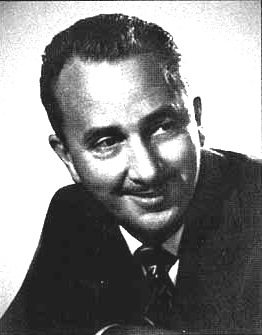
OK, but I digress, because like I said, we’re really not concerned with Past and Present; the Future is our subject today. And what a subject it is! Gordon Jenkins composed the piece from scratch, and he conceived of it as one large-scale composition in a series of movements. Jenkins’ signature sound is extremely lush, symphonic, classically-oriented, with a definite proclivity for dark string saturated orchestral colors. His arrangements are often very dramatic. Take for example his intro to “Autumn Leaves” from 1957:
Now honestly, would you ever have guessed in a hundred years that that was an intro for “Autumn Leaves”?? Don’t get me wrong, “Autumn Leaves” is a beautiful song – one of my favorites, in fact – but it’s a simple affair harmonically, and it’s usually presented in a straightforward fashion. In the hands of Gordon Jenkins, it ends up sounding like Sergei Rachmaninoff, Bernard Herrmann and Ernest Chausson teamed up to write the prelude to their next tragic opera — that is to say, GREAT!
So, now that we know what Mr. Jenkins is capable of – gorgeous, expansive, music which may not exactly suit its context – it’s time for us to take a look into the Future. My best research indicates that Mr. Jenkins served as both composer and lyricist for this… well, what is it really? Song cycle? Symphonic ode? I have no idea. What I can tell you is that it’s not only the strangest thing I’ve ever heard Sinatra sing, but that it’s one of the most unique 20th century compositions known to me. The Future is essentially a monodrama for Sinatra, Chorus and Orchestra. Much of Sinatra’s vocal line is written in a wandering, pseudo-melodic recitative style. The score is occasionally sprinkled with aimless tunes, and often interrupted by “narrative” soundtrack elements and phantom feminine voices. Gushing orchestral interludes, like the one above, abound.
You’ve really got to hear it to believe it though, so let’s jump right in. The work is in six movements:
1. What Time Does the Next Miracle Leave?
Stephen Sondheim has said that the very first notes of a musical should set the tone for the entire show (a lesson he learned from West Side Story) and I think Gordon Jenkins does just that in his opening: we know that this is going to be an “autobiographical” work, we know that it will feature both a chorus and an orchestra, and we know that the next 50 minutes of music are going to feature an incomprehensibly bizarre mix of the banal and the sublime.
The lyrics continue:
I’ve had some very good years
[extended orchestral interlude on “It was a very good year”]
I haven’t missed a whole lot in those firecracker years
And I don’t want to miss a thing when the future appears
Then Frank shares some of his simpler pleasures with us:
You’re talkin’ my language, Frankie boy! It turns out that while he’s reclining with said beverage, Mr. Sinatra likes to “look at the stars.” He continues:
Now, this clip is indicative of much of what we’ll hear on the album, so let’s examine it a bit more closely. We have three parts: 1) a continuation of the quasi recitativo ramblings, 2) the overhead speaker announcing the itinerary of Sinatra’s imaginary spaceship – these narrative sound-design elements will feature heavily in the album, and will go a long way to creating the sort of soundtrack feel to the whole thing, and 3) something that, compared with the other music in the score might be considered a “tune”.
The voice on the overhead monitor counts down to the lift-off, depicted by particularly strange, 1940’s sci-fi-esque orchestral episode. First stop:
a) Venus
And why shouldn’t Frank Sinatra assume that when he arrives at Venus he’ll encounter the girl who’s been waiting for him for oh so long? Makes sense to me. This first planetary sojourn establishes an important precept for this section: the visit on each planet is a representation of said planet’s mythological counterpart, i.e. Venus is the planet where Frank falls in love, etc.
b) Jupiter and Saturn
Despite the fact that Jupiter and Saturn are the solar system’s two largest planets, they receive one very brief stop by Sinatra and crew. The music is a sprightly little jig, with the following lyrics:
Jupiter makes with the rain
Saturn makes with the crops
A nicer trade was never made
And hopefully never stops
c) Pluto
I think that just about speaks for itself.
d) Mercury
Mercury (the messenger) gets very short shrift, just one line in fact: Mercury will lead us out to Neptune. As a side note, let me mention that there’s really no point in trying to figure out the order in which these episodes are presented, all astrological maps having been left home on planet earth.
e) Neptune
Neptune is represented by its “deep, blue sea”. Again, mythological, not geological (geological? that can’t be the right word… neptological? that just sounds wrong.) Here we come to perhaps the most beautiful of the many, many orchestral interludes that pepper this score, a sort of Holst-Ravel-Debussy-Max Steiner fantasy on the theme of the Sea:
f) Uranus
The Uranus sequence is the least successful of the bunch, but it does present two thematic elements that will be very important to the rest of the piece: the use of an unidentified, disembodied female voice; and a hackneyed stereotype of Italian mandolin music.
The “Satellite Special” then heads back for earth, and let me assure you, zany hi-jinks ensue. Since we’re back at earth, let me just put in my first plug: buy this album. You won’t be disappointed.
2) World War None!
Jenkins’ second movement is far less ambitious than the opening ten minute epic; “World War None” is basically a song in the traditional form, complete with verses and choruses. The musical language is sort of Borodin meets Lawrence of Arabia meets Wagner meets Vegas lounge lizard. Picardy thirds abound and express the optimism of a world without war. The lyrics defy easy categorization… in one sense, they’re on the triter side of Jenkins’ spectrum, but the rhyme schemes are much more successful, in that the words do actually rhyme occasionally.
3) The Future
Here begins an interior suite of three sections, the connective tissue being a trip to a Gypsy to get Sinatra’s fortune told… well, not Sinatra‘s future, per se, but another disembodied female’s fortune told, I guess…
Interesting how Jenkins could channel Claude Debussy in writing the blues. Also, note the appearance of the famous “button pushing” motive at the end there.
BTW, it’s definitely worth pointing out that that last segment contains the most explicit references to anything actually having to do with a time beyond 1980 – that is, the future – of anything on the entire album.
The chorus informs Sinatra that if he lets his “imagination burst into flame, it will let [him] do whatever he damn well choos[es] to do.” Sinatra:
And then follows another ravishing interlude for the orchestra:
p.s. That magic wand that Frank mentioned earlier? That was a baton.
Also, notice in the lyrics I quoted above the phrase “damn well choose”. We’ll see more later how sussing seems to be a very important device in Jenkins’ lyrical toolbag.
4) The Future (con’t): I’ve Been There
This segment begins with a minute-long intro from the chorus, and continues with another “song” called “I’ve Been There”, which could actually be kind of decent as a song if it had an actual tune and was about anything:
The orchestration is quite nice though, and definitely contains the most contemporary (Costa-esque) sound to it, which I guess is as close to the future as this thing is going to get, musically speaking.
5) The Future (con’t): Song Without Words
The Mendelssohnian titled final installment of “The Future” mini-suite is notable for the fact that, of it’s 6 minutes and 11 seconds of music, Sinatra sings for only 30 seconds of it. Jenkins is ready with yet another choral prelude (including a third disembodied female voice, singing about building a house on a star), and at least 2 lengthy orchestral meditations.
6) Before the Music Ends [Finale]
A piece like the Future demands a finale of considerable weight and power, and Gordon Jenkins does NOT disappoint. This movement makes a fine bookend with the opening, matching it in length and scope. Sinatra opens the piece waxing poetic about his past. The chorus, ever ready, jumps in and asks:
(See what I said about the cussing?)
[Editor’s note: does that music as the clip trails off remind anyone a LOT of the Finale Ultimo of Cabaret? I think it’s the harmonies. Just a thought.]
“Before the Music Ends” refers to the many things Sinatra wants to do before he dies. Ironically, these involve visiting many locations from his past:
Let’s take a closer look at the rhyme scheme here, certainly among Gordon Jenkins’ most ambitious poetry in the whole piece:
Before the music ends
I must go
to Ho-
boken
Interior rhymes, mid-word enjambment… is this Gordon Jenkins or e. e. cummings?? Also, I love how the music suggests that the Hoboken of Sinatra’s youth was squarely situated in Western Slovenia or Lombardy or someplace.
After Sinatra glumly leaves Hoboken, we take a pause in the narrative so that Sinatra can offer his personal thanks to a series of composers of the classical cannon:
For now let’s ignore Gordon/Frank’s fast and loose use of jocular nick-names with history’s greatest composers – in this piece it somehow makes a world of sense. My question is, what if any connection does Sinatra have with these classical composers? Since when was he such a Puccini specialist that the mere sound of Giacomo’s first name elicits this kind of treatment?
These, and so many other questions are really for the ages, so let’s continue our journey, shall we? After this transcendental foray into the history of classical music (again, what does any of this have to do with the future?), Frank makes one last charge at Vegas, accompanied by “Dino” (Dean Martin) and “Sarge” (Sarge Weiss, I’m guessing, Sinatra’s ersatz musical producer on some TV work in the 60’s). The trip to Vegas consists of Sinatra explaining why he prefers shooting craps to all other forms of gambling:
The Vegas sequence is capped off by a brief threnody for solo cello (isn’t that exactly what you were expecting by this point??) which leads into the Grand Finale, a slow build-up in which Sinatra commissions one last song before he dies and records it with “the best musicians in the world”. Brass blare, timpani pound and the chorus intones the final words:
Only one man could refer to Death as “that cat with a scythe” and then invoke the finale of Shostakovich’s 5th symphony in one stroke of the pen. That man is Gordon Jenkins, and to him I am ever grateful for composing this strange universe of the Future. Critics, of course, panned it, many of them taking solace in the fact that Future‘s oddities couldn’t ruin an otherwise great trilogy album. I couldn’t disagree more. I think the first two records are musically bankrupt – they’re totally anti-septic and make you yearn for the old Sinatra. The Future, on the other hand, is an imaginative cornucopia, a bizarre smorgasbord of endlessly entertaining delights.
So many questions remain. For me, the primary among them is: did Gordon Jenkins REALLY pen all the lyrics to this piece? Might it not have been Sinatra himself? Or at least have had a hand in them? Was Gordon Jenkins, at the age of 70, perhaps overlooking the precipice of dementia? Were these all trunk songs/arrangements that had been seeking an outlet for decades and finally saw the light of day on this project?
Frankly (pun very much intended), these are the kinds of questions that make the Future worth listening to. Speaking of which:
